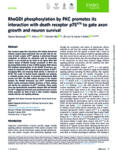The Journal of Neuroscience publishes today our paper on the role of the GDNF receptor GFRa1 in the main olfactory system (Marks et al. 2012). In this work, we investigated the consequences of GFRα1 deficiency for mouse olfactory system development and function.
GDNF and its receptor GFRα1 are prominently expressed in the olfactory epithelium (OE) and olfactory bulb (OB), but their importance for olfactory system development has been unknown. In the OE, we found that GFRα1 was expressed in basal precursors, immature olfactory sensory neurons (OSNs), and olfactory ensheathing cells (OECs), but was excluded from mature OSNs. The OE of newborn Gfra1 knock-out mice was thinner and contained fewer OSNs, but more dividing precursors, suggesting deficient neurogenesis. Immature OSN axon bundles were enlarged and associated OECs increased, indicating impaired migration of OECs and OSN axons. In the OB, GFRα1 was expressed in immature OSN axons and OECs of the nerve layer, as well as mitral and tufted cells, but was excluded from GABAergic interneurons. In newborn knock-outs, the nerve layer was dramatically reduced, exhibiting fewer axons and OECs. Bulbs were smaller and presented fewer and disorganized glomeruli and a significant reduction in mitral cells. Numbers of tyrosine hydroxylase-, calbindin-, and calretinin-expressing interneurons were also reduced in newborn mice lacking Gfra1. At birth, the OE and OB of Gdnf knock-out mice displayed comparable phenotypes. Similar deficits were also found in adult heterozygous Gfra1+/− mutants, which in addition displayed diminished responses in behavioral tests of olfactory function. We conclude that GFRα1 is critical for the development and function of the main olfactory system, contributing to the development and allocation of all major classes of neurons and glial cells.
Read the full paper HERE.



